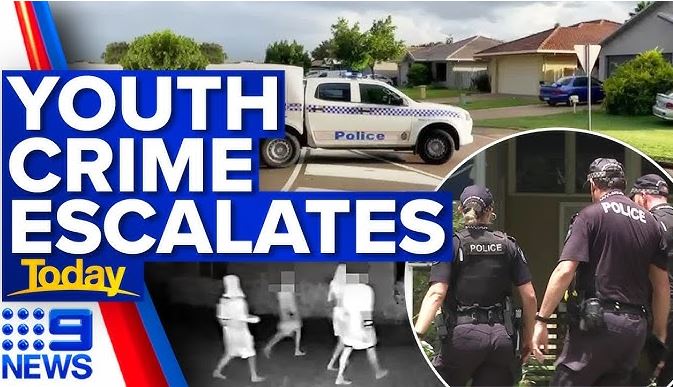Youth crime is the victim of ideology that is so blinkered as to fail to achieve its original goal.
In the late 1990’s to 2012 a formidable politician, Robert Hulls, championed a concept called Restorative Justice.
A concept, ironically given its devout following in Victoria’s Judicial fraternity, that has not exactly achieved worldwide acclaim or even acclaim to any great degree Nationally.
For all its warm-fuzzy ideological appeal, the concept remains just a theory, and we are paying the penalty of having our Justice system hijacked by a theory that, in practice, has failed, hence the lack of acclaim.
Look no further than the juvenile crime statistics over the last two decades to see the abject failure. This era was preceded by a Victoria Police Policy of proactive policing targeting young people and building bridges. A policy that worked.
The definition of Restorative Justice published by RMIT, is clearly an ideological joke gone disastrously wrong, and sane people should never have allowed it to permeate the justice system as it currently has.
Restorative justice is a theory of justice that focuses on the harm caused by crime and wrongdoing to people, relationships and communities.
It provides a framework for addressing and preventing harm that moves beyond punishment towards healing. As a practice, restorative justice processes most commonly bring together people affected by harm in a safe, structured and facilitated way, to talk about what happened, how they were impacted and how the harm can be repaired or addressed.
https://cij.org.au/opencircle/what-is-restorative-justice
It is a fat lot of good having victims, sometimes of horrendous crimes, being confronted in a congenial environment with the perpetrator for ‘a healing’; ‘a healing for who’?
Healing the perpetrator does nothing for the poor Victim who not only has to suffer the consequences of the crime but is then called up for ‘a healing’, not for them, but for the perpetrator.
That this process would somehow reduce the likelihood of the perpetrator reoffending is an academic fantasy.
One major failing is this theoretical concept has been interpreted by the judiciary and others as a process to assist perpetrators and perhaps turn their lives around. The operative word is, perhaps, because, to those who know and understand the psyche of the young, it is highly unlikely to achieve the desired outcome.
Juvenile offenders know only one concept, and that is their personal advantage as they see it, and the impact on anybody else is immaterial.
When juveniles from a particular cohort are charged and convicted by a court, the perpetrator perceives only two options. If they walk from the court, they have beaten the charge, or they can be sent to prison, a badge of honour to be bragged about.
Lawyers and the Judiciary might as well save the energy from dissertations directed at a convicted juvenile perpetrator as they explain how wrong the actions are and that a diversion will be their ‘last chance’. Rhetoric without consequences, they have no doubt heard many times, making the threat useless.
So, no matter what might be said or recorded or otherwise by the Court, if the perpetrator walks from Court, their bragging rights herald, ‘I won’, and will be broadcast loudly amongst their peers. That has a knock-on effect of impunity from any consequences, emboldening others to commit crimes.
The Court’s focus on the individual perpetrator is important, but the Court has an obligation to the broader community, particularly other young people likely to offend.
That leaves us with a system that rewards, not punishes criminality, in the perpetrator’s mind’. Any deterrent effect is disastrously lost on any peers of the perpetrator as they can demonstrate that no matter what they do, nothing happens.
If reparation was enforced on the juveniles and or their family, it would at least be a tangible deterrent.
The best option to reduce juvenile crime is to prevent it by reintroducing proactive programs like,
- Blue Light Discos (Blue Light survives, but the discos have all but disappeared).
- The Police in Schools Program, which ran very successfully in Victoria from 1969 until 2006. (The current iteration is similar in name only; the very effective Curriculum-based version is no longer used.)
- Operation New Start was a program actively ensuring young people actually get to school.
- Derby Hill – a Blue Light resource used as a school camp. Local Police could spend time with their local children in a school camp orientated to Policing. The camp has been disposed of.
Early structured connection of police with juveniles pays high dividends in reducing offending. All of these programs had one remarkable similarity. When each was introduced, there was an immediate reduction in local juvenile crime.
Another option to reduce the frequency and severity of juvenile crime is incarceration, particularly for repeat offenders—understandable consequences for society and the juvenile.
Unfortunately, there is only one option to reduce the frequency and severity of juvenile crime, and that is incarceration—understandable consequences, not for society but for the juvenile.
Jail is not the place for young people; neither is it appropriate or in their best interest for them to rape, rob and pillage society.
Shorter sentences will be the answer because time for young people moves extremely slowly, so a month or two with a generous good behaviour incentive would be more effective than any extended period to avoid the risk of institutionalisation and create a break in the nexus the juvenile has with their current peers.
Jail per se is not the problem; it is how this resource is used. Threats alone will never succeed, and the resource needs to be used more creatively and effectively.
After a relatively short period, the perpetrator’s peers will move on without the juvenile, a good outcome that gives the juvenile the chance to start again.
While jail should not be a holiday home, the discipline and proper management of juveniles will help them.
If the problem is perceived to be the jail, then fix the jail.
It’s their liberty that has to be sacrificed. A month without access to a mobile phone would be a great start on the road to a crime-free life.
In serious cases, it is the juvenile offender’s liberty that must be sacrificed to protect the Juvenile and the Victims.
The reduction starts with creative and effective pro-active programs to reduce crime in the first place and then pragmatic and effective management of perpetrators to guide them from their current path.
This will ultimately save lives, predominantly of the perpetrators. Crime can be a fatal endeavour.


Tackling youth crime is not that difficult and the past has proved my point. Instead of psychologists all diagnosing young people with emotional issues which the courts accept as true or politicians raising the age of responsibility, thus, telling kids that they dont know right from wrong which is nonsense, we need to go back in time and enforce discipline in the home and the parents need to act as role models and correct kids when they go off the rails. Today, there is no discipline in schools and children refer to their teachers by their first names which places kids and teachers on the same level. When i was at school in the 70’s, if I referred to my teacher by their first names, id be of to the principle’s office and if lucky get just one canning. The reality is, kids today are more street savvy than they were 40 years ago and they use this street knowledge to get away with bad behaviour. We have welfare groups who demand that juvenile detention centres be less intimidating and more friendly. Im curious, where is the deterrent if juvenille centres and prisons are a home away from home – there is none. Until adults wake up and start looking after their kids, rather than kids threatening parents, teachers, police etc with legal action just because they dont like curfews etc, then the problem will just escalate.
Is there still a high deterrent rate with the Cautioning Programme or is this no longer an appropriate early intervention approach?